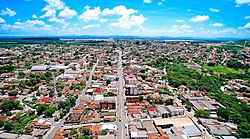Uruaçu
Municipality in Central-West, Brazil From Wikipedia, the free encyclopedia
Municipality in Central-West, Brazil From Wikipedia, the free encyclopedia
Uruaçu is a city and municipality in north Goiás state, Brazil.
Uruaçu | |
|---|---|
 View of Uruaçu | |
 Location in Goiás state | |
| Coordinates: 14°31′10″S 49°08′42″W | |
| Country | Brazil |
| Region | Central-West |
| State | Goiás |
| Area | |
| • Total | 2,141.7 km2 (826.9 sq mi) |
| Elevation | 520 m (1,710 ft) |
| Population (2020 [1]) | |
| • Total | 40,840 |
| • Density | 19/km2 (49/sq mi) |
| Time zone | UTC−3 (BRT) |
| Postal code | 76400-000 |
| Website | www |
Uruaçu is located north of Anápolis and Goiânia on the important interstate highway BR-153, which links Brasília to Belém. It is 269 km. from Goiânia and 244 km. from Brasília. It belongs to the Porangatu Microregion.
Municipal boundaries are with:
On the west the municipal boundary follows the Serra Dourada mountains, where the Passa Três river has its source and supplies the city with its drinking water. On the east the boundary is formed by the Serra da Mesa reservoir (43 meters deep and 1,784 km2 in area).
The climate is moist tropical, with maximum temperatures of 38 °C, minimums of 18 °C and an average of 28 °C.
The origin of this town was the Passa Três ranch acquired by the Fernandes family in 1910 and located in the municipality of Pilar de Goiás along the route used by muleteers and merchants from the south. In 1913 Coronel Gaspar donated lands to build a chapel dedicated to Saint Anne and the settlement was called Sant'Ana. In 1924 the settlement was raised to a district and in 1931 it became a municipality. In 1943 the name was changed to Uruaçu, which in Tupi-Guaraní means "large bird". In 1948 Uruaçu lost the district of Porangatu, which became the municipality of Porangatu, now the most important city in the region. in 1953 it lost the district of Amaro Leite, which became the municipality of Amaro Leite, later changed to Mara Rosa.
In January 2013 the mayor was Solange Abadia Rodrigues Bertulino. The population density was 15.59 inhabitants/km2 (2007). Urban population was 36.929 (2010) while rural population was 3,070 (2007). The town has lost about 1,000 people since 1980. There was a -0,11% growth rate for 1996/2007.
The economy is based on subsistence agriculture, cattle raising, services, public administration, and small transformation industries.
In the educational sector there were 46 schools with 10,693 students in 2006. In higher education there was a campus of the UEG - Faculdade de Educação, Ciências e Letras de Uruaçu. The adult literacy rate was 85.7% (2000) (national average was 86.4%). The town was served by 2 hospitals with 113 beds in 2007. The infant mortality rate was 27.33 (2000) (national average was 33.0).
Seamless Wikipedia browsing. On steroids.
Every time you click a link to Wikipedia, Wiktionary or Wikiquote in your browser's search results, it will show the modern Wikiwand interface.
Wikiwand extension is a five stars, simple, with minimum permission required to keep your browsing private, safe and transparent.